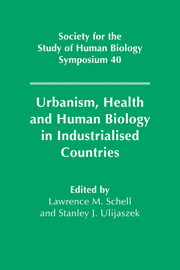Book contents
- Frontmatter
- Contents
- List of contributors
- Part I The urban environment
- 1 Urbanism, urbanisation, health and human biology: an introduction
- 2 Urbanisation and urbanism in industrialised nations, 1850–present: implications for health
- 3 Urban development and change: present patterns and future prospects
- 4 Transitional environments: health and the perception of permanence in urban micro-environments
- Part II Epidemiology
- Part III Poverty and health
- Part IV Behavior and stress
- Part V The future
- Index
1 - Urbanism, urbanisation, health and human biology: an introduction
Published online by Cambridge University Press: 06 January 2010
- Frontmatter
- Contents
- List of contributors
- Part I The urban environment
- 1 Urbanism, urbanisation, health and human biology: an introduction
- 2 Urbanisation and urbanism in industrialised nations, 1850–present: implications for health
- 3 Urban development and change: present patterns and future prospects
- 4 Transitional environments: health and the perception of permanence in urban micro-environments
- Part II Epidemiology
- Part III Poverty and health
- Part IV Behavior and stress
- Part V The future
- Index
Summary
‘The city is a fact in nature, like a cave, a run of mackerel or an ant heap. But it is also a conscious work of art, and it holds within its communal framework many simpler and more personal forms of art. Mind takes form in the city; and in turn, urban forms condition the mind.’
Lewis Mumford, The Culture of Cities (1938)The world is becoming an increasingly urban place. Current estimates indicate that one half of the world's population will be living in urban centers by the year 2005, largely the result of but two centuries of rapid urbanisation, and there are no apparent social forces that strongly oppose it.
Urbanism involves the concentrated inhabitation of human populations in relatively small areas, while urbanisation is the process of becoming urban and includes population growth by migration, natural increase and the changing scale of economic activity associated with this change. Both influence human biology and behavior in ways distinct from rural lifeways. Humans, like all other living things, are affected by their environment, whether that environment is completely unaltered by human activity or made entirely from it. Evolution and adaptation continue to operate in human populations through differentials in morbidity, mortality and reproduction.
- Type
- Chapter
- Information
- Publisher: Cambridge University PressPrint publication year: 1999
- 8
- Cited by



